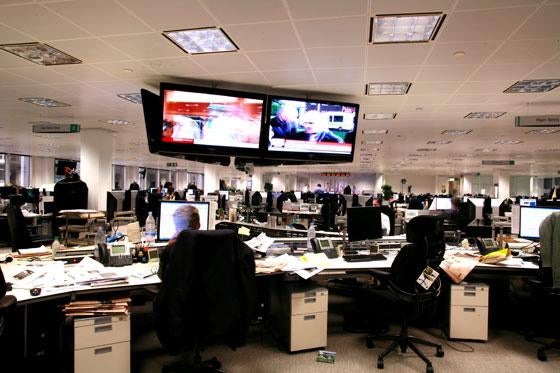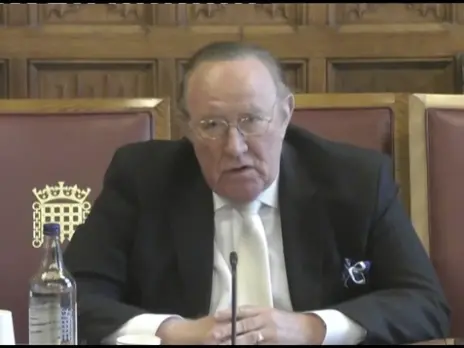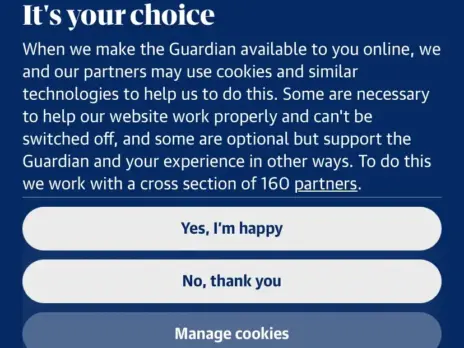
Journalists who have never stepped foot in a war zone are nonetheless becoming traumatised by witnessing violent or distressing scenes through their computer screens.
Known as “vicarious trauma”, it has become a growing cause for concern as reporters can be exposed to graphic images and video via the internet and unfiltered newswire feeds.
Currently there is rarely any training or support given to those who might experience vicarious trauma and only select newsrooms have support systems in place for staff.
Gavin Rees, executive director of Dart Centre Europe, which has been providing advice and support to journalists who cover trauma and violence since 2003, said vicarious trauma is “the idea that people can be affected by traumatic incidents they are not directly exposed to”.
He said there were two main ways in which it can be triggered – by seeing, “so it could be people looking at traumatic images or high definition video of traumatic acts taking place”, and hearing.
But simply looking at traumatic images or hearing traumatic accounts doesn’t mean that you are traumatised, said Rees.
“What we have to look out for is the point at which it starts to bite and starts to affect the way people are…
“There is a big difference between looking at something and being angry and then because you saw that thing four weeks ago still being angry about it four weeks later – in other words getting stuck in that place.”
Rees said the problem of vicarious trauma had been understood for a “long time” in clinical psychology but had tended not to be seen as an issue for journalists.
He said: “The idea has always been that the journalist is somehow like a very efficient, ultra-rational recording machine who is not affected by what they witness and what they hear.”
Rees said concerns had been first been raised within the news industry around the start of the Iraq War in the early 2000s when high-quality images showing traumatic injuries were coming through newswires.
In particular, a tape released to the public in 2004 of British hostage Ken Bigley being beheaded by Islamist militants which was verified by press at the time led to discussions in newsrooms about limiting who should see the footage.
A decade later and Isis (Islamic State) began again publishing graphic executions of captives, including American journalist James Foley, which also had to be verified by the press. Meanwhile footage from the Syrian civil war continued to flood the wires.
“The thing that has changed now is a growing understanding within the media profession that the very high volume of extremely graphic video and audio material that’s coming into newsrooms can also have an impact on staff even if they are 1,600 miles away from Syria,” said Rees.
“If you’re sitting in a room and you’re watching very high-quality images of murder and mutilation your brain doesn’t necessarily know or understand that that material is not happening around you. It’s almost as if effectively our body goes into a kind of trauma response mode.”
He also said technology meant journalists could be witnessing traumatic incidents outside of the office, for example receiving work emails containing graphic content to their mobile phone.
Rees said that within the news industry, newspaper journalists were at more risk of developing vicarious trauma than broadcasters and that one of the biggest problems was staff not seeking help when they need it.
He said: “TV broadcasters tend to be more aware and that’s partly because they have a more established tradition of team working, with reporters and producers all working together – there is a slightly more collegiate tradition.
“Whereas newspaper journalists tend to be a bit more individualistic and may not be working with the same people on the road. They are more isolated, there are less colleagues around to monitor how they are doing.”
Rees said the recent terror attacks in London and the Grenfell fire tragedy (pictured above), all of which happened within a four-month period and resulted in more than 100 deaths, had “focused attention” on vicarious trauma.
“Newspapers are now more aware of this than they were ten years ago,” he said. “But there’s a lot that can be done…but because if we want journalists to be productive and effective it’s vital that they look after themselves and their organisations do everything in their power to help them do that.”
Alicia Melville-Smith, 28, a breaking news reporter with Buzzfeed UK in London has experienced vicarious trauma first-hand, leading to her taking time off from work and having counselling.
She had been on shift when both the Westminster and Manchester terror attacks broke, providing rolling coverage of the incidents as more information came to light and filtering mobile footage taken from the scenes and shared on social media.
She said: “We had videos coming up from the Manchester bombing before the press photographers got there, because obviously you’ve got a lot of young people with phones and loads of them were recording while it happened because they were at a concert – so there was a lot of videos on Twitter and Facebook of the explosion, the screams and the aftermath.”
The London Bridge terror attack on Saturday, 3 June, broke while Melville-Smith was on holiday in Spain – already cut short due to the general election – forcing her to work a few days before heading home and back to the office, she said.
It was during her shift the day after returning to work that she said she started to feel “strange”.
“By this point I don’t know what happened, I was just exhausted,” she said. “I came into work on Tuesday and I was working along fine but I just started to feel really strange, almost like I was disassociating. One of my colleagues kept asking me ‘are you ok?’”
Melville-Smith said it was while researching an obituary about a victim of the London bridge attack who was from the same place as her in Australia and shared mutual friends that she “started to get really panicky” and “upset” and went in to speak with Buzzfeed UK editor Janine Gibson.
“I just completely fell apart and I was like ‘I can’t do this’. I was hyperventilating, I was crying. I had been having nightmares for a couple of days and I wasn’t sleeping properly and so she sent me straight home and said go straight to the doctor.
“I went to the doctor and he said I needed to be signed of work and that I was too stressed out. I said I cover this kind of stuff every day, it shouldn’t be an issue, and so I felt a lot like I was failing.
“And then I was off for two and a half weeks, just resting, and I went back to work and it was fine.”
She said it was it while having counselling that she first heard the term vicarious trauma to explain what she was going through. She said: “That’s basically what happened to me: I was traumatised by other people’s trauma.
“Even though I hadn’t been on the street and seen it, reading about it, writing about it, looking at the pictures, interviewing the people had been enough to push me over the edge.
“I knew that obviously looking at Isis videos and that kind of stuff could be difficult because I’ve done that, I’ve looked at all of them and sometimes you need to step away you feel a bit shitty – but I didn’t realise it could manifest in that way where I was physically ill.”
She said it had been “helpful just to understand” what had happened to her, saying: “I thought I just got overwhelmed, or was tired, or something happened to me. And then to have someone tell you there’s a name for it, there are symptoms, it’s a proper thing.
“The therapist was saying to me that in industries like police and firefighting they would have regular training and they are more prepared for it, because that’s their job day-to-day. And I think with journalism the way technology has moved so quickly, we just haven’t caught up.
“And it’s not any one company or anything, it’s the industry as a whole.”
Melville-Smith said one of her biggest problems has been switching off from work – checking emails and Twitter even after leaving the office – and that she had had to learn to step back.
She added: “It’s little things like just breathing exercises and mindfulness which can help in terms of just stepping away and relaxing.”
She called on journalism courses to include training to educate journalists on vicarious trauma and inform them about what signs to look out for and how to cope with it. She said she’d had the symptoms for “quite a few weeks before it got to the point where it was all of them all at once”.
She said: “I think what the industry needs to do as a whole is to be more aware of it at all times. Not just a big thing happens and they’re like if you need help come to us – that’s great but I think we need to be more aware of it before it happens. Just making it part of your day-to-day training.”
Social media news agency Storyful has a team of up to 50 journalists worldwide, including those based in Dublin and London, who find and verify content shared on social media around news stories.
For director of news Joe Galvin not only does the nature of digital and social news mean that journalists “can be exposed to some pretty horrific stuff”, but he said online abuse directed at journalists, in particular women, is also becoming part of the problem.
He said he knew anecdotally of at least ten journalists in Storyful who had spoken about being affected by the content they were working on, adding: “That’s just scratching the surface. I would say that if ten felt free to speak about, more might have been affected.”
Those affected by vicarious trauma include Galvin himself who said he experienced symptoms after seeing graphic images from the 2014 Gaza conflict.
“The way it manifested itself was in very low moods, he said. “I had been having nightmares frankly about certain images I had seen. I wasn’t coping very well, my motivation to come into the office was very poor and it was just very upsetting to me.
“It was particularly related to these children on a beach who had been struck by Israeli shelling and their bodies were carried out by a Norwegian journalist. I think it was more the straw that broke the camel’s back than something in and of itself.
“For me it was just the relentless nature of that and it was so well documented on social media with relentless imagery, quite brutal imagery, at the same time we were working very diligently on the Syrian civil war with similar types of atrocities on a day-to-day basis and it think it all just came to a head in that particular moment.”
He said he would be in a “very low mood” even at home, adding: “My wife, then partner at the time, flagged it to me saying something wasn’t right. I knew myself that something wasn’t right but her saying it to me made me want to address it.
“I used our counselling service – I was very glad to have it available. I had never used services like it in the past and it did make a big difference.”
He said staff at Storyful talk openly about the issue of vicarious trauma and that as a result there was “no stigma or shame attached to it” and company training meant it was “on all of our minds”.
“Knowing that and having that information and also having access to the services made an easy decision as regards to what to do next,” he said. “If all that environment hadn’t been in place, it could have continued on and I probably wouldn’t have addressed it as promptly as I did.”
He said he thought the news industry was “becoming more aware” of vicarious trauma, but that Storyful was one of the few companies to have taken an “active stance” on it.
He added: “The research has been done, it’s quite conclusive that vicarious trauma is a real thing and it has an impact on people’s lives and their well-being.
“As a result it’s incumbent on us to deal with that, accept the research and put in place proper safeguards that help the journalists deal with that and get through it.”
What newsrooms can do to tackle vicarious trauma:
“The first thing is awareness,” says Gavin Rees of the Dart Centre.
“It’s really important that newsrooms create a culture in which journalists are allowed to think about their own reactions and self-care needs.
“We know that if journalists don’t sleep properly that’s much more likely to lead to trouble, so valuing things like rest and recuperation are really important.
“There are lots of simple stress management techniques that are being used very extensively in the military like deep-breathing exercises, different kinds of relaxation, which we know can help avoid the tightening ratchet affect of cumulating traumatic stress.
“Simple peer support, a sense of connection with other journalists, that people have each other’s backs is very important. It’s certainly very important that manager’s understand that when they are working with a team that’s under a lot of trauma pressure that they really have to up their people skills.
“Thinking about how folk are doing and not making unreasonable demands on people at a time when they may be already right at the edge of what they can do.”
Useful links:
- First Draft – Guide: Journalism and Vicarious Trauma
- Dart Centre – Handling Traumatic Imagery
- Inside Storyful: Vicarious Trauma and Ensuring the Well-being of the Newsroom
Email pged@pressgazette.co.uk to point out mistakes, provide story tips or send in a letter for publication on our "Letters Page" blog






